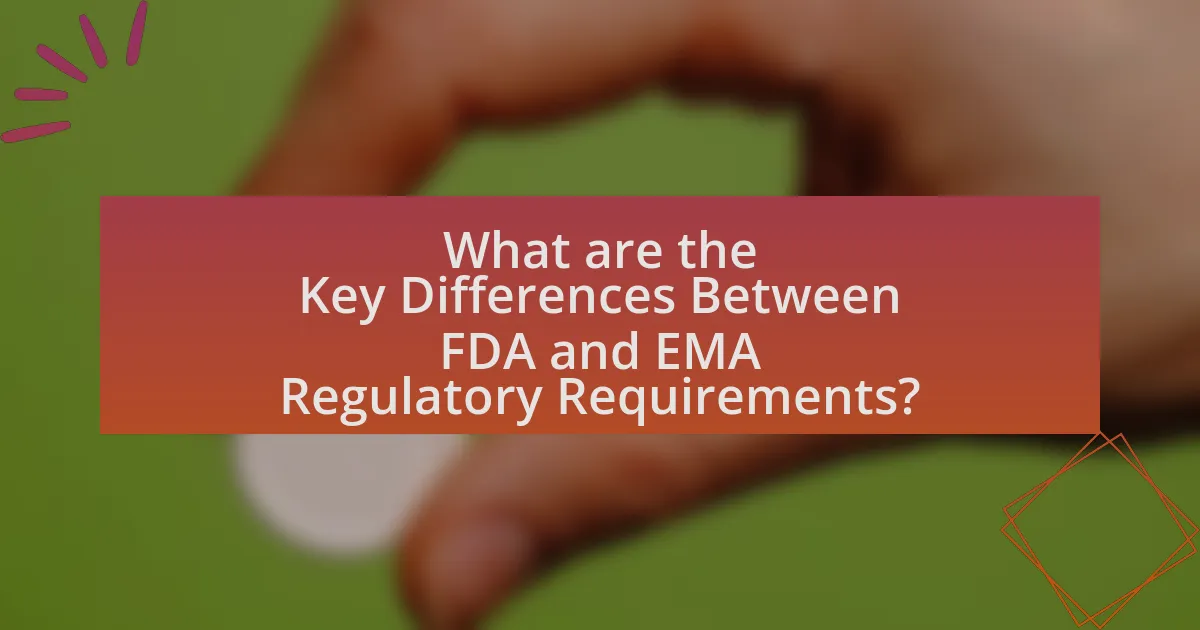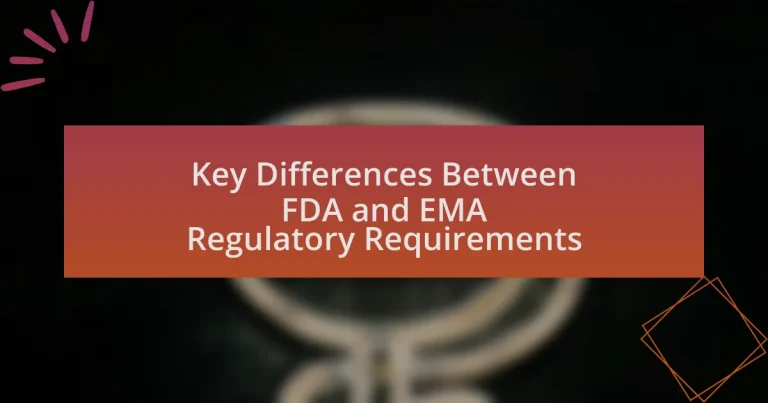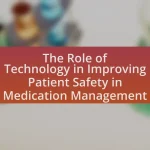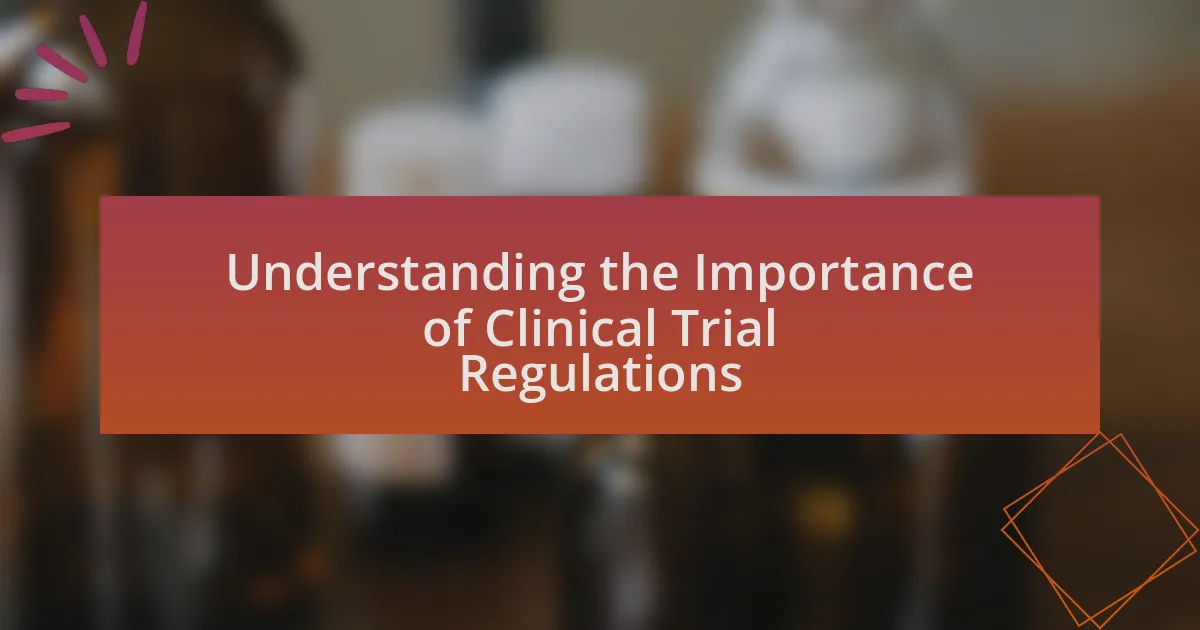The article examines the key differences between the regulatory requirements of the U.S. Food and Drug Administration (FDA) and the European Medicines Agency (EMA). It highlights distinctions in approval processes, data requirements, and post-market surveillance practices, noting that the FDA generally offers a faster approval timeline while the EMA emphasizes comprehensive evaluations. The article details the steps involved in both agencies’ approval processes, their objectives regarding public health and safety, and the implications of these regulatory differences for pharmaceutical companies. Additionally, it discusses best practices for compliance and effective communication with regulatory bodies.
What are the Key Differences Between FDA and EMA Regulatory Requirements?

The key differences between FDA and EMA regulatory requirements include the approval processes, data requirements, and post-market surveillance practices. The FDA typically has a more streamlined approval process, allowing for faster access to new drugs, while the EMA emphasizes a more comprehensive evaluation, often resulting in longer review times. Additionally, the FDA may accept data from clinical trials conducted outside the U.S. with fewer restrictions, whereas the EMA requires more extensive data from European trials. In terms of post-market surveillance, the FDA focuses on risk management plans, while the EMA mandates more rigorous pharmacovigilance activities. These differences reflect the distinct regulatory philosophies and healthcare priorities of the United States and Europe.
How do FDA and EMA regulations differ in their approval processes?
FDA and EMA regulations differ primarily in their approval processes through distinct pathways and timelines. The FDA typically follows a faster approval process, often allowing for expedited pathways like Breakthrough Therapy Designation, which can significantly shorten the review time. In contrast, the EMA employs a more structured approach, including a centralized procedure that requires a comprehensive evaluation by multiple member states, which can extend the timeline for approval. Additionally, the FDA emphasizes post-market surveillance and risk management plans, while the EMA focuses on a more collaborative approach with member states during the assessment phase, leading to differences in how data is reviewed and utilized.
What are the steps involved in the FDA approval process?
The FDA approval process involves several key steps: preclinical testing, Investigational New Drug (IND) application, clinical trials, New Drug Application (NDA), and FDA review. Initially, preclinical testing is conducted to assess the safety and efficacy of a drug in laboratory and animal studies. Following successful preclinical results, a sponsor submits an IND application to the FDA, which includes data from preclinical studies and a plan for clinical trials.
Once the IND is approved, clinical trials commence in three phases: Phase 1 focuses on safety and dosage, Phase 2 evaluates efficacy and side effects, and Phase 3 confirms effectiveness and monitors adverse reactions in larger populations. After completing clinical trials, the sponsor submits an NDA, which contains comprehensive data on the drug’s safety, efficacy, and manufacturing processes.
Finally, the FDA reviews the NDA, which may involve advisory committee meetings, and makes a decision to approve or deny the application. If approved, the drug can be marketed in the United States. This structured process ensures that drugs are thoroughly evaluated for safety and effectiveness before reaching consumers.
What are the steps involved in the EMA approval process?
The steps involved in the EMA approval process include the following: submission of a marketing authorization application (MAA), validation of the application, evaluation by the Committee for Medicinal Products for Human Use (CHMP), opinion issuance by the CHMP, and final decision by the European Commission.
Initially, the applicant submits the MAA, which is then validated to ensure completeness. Following validation, the CHMP conducts a scientific evaluation of the application, assessing the quality, safety, and efficacy of the medicinal product. After the evaluation, the CHMP issues an opinion recommending approval or refusal. Finally, the European Commission makes the binding decision based on the CHMP’s opinion, which typically takes about 67 days. This structured process ensures that all medicinal products meet stringent safety and efficacy standards before reaching the market.
What are the primary objectives of FDA and EMA regulations?
The primary objectives of FDA and EMA regulations are to ensure the safety, efficacy, and quality of drugs and medical products. The FDA, as the U.S. regulatory body, focuses on protecting public health by overseeing the approval and monitoring of pharmaceuticals, while the EMA, serving the European Union, aims to facilitate the development and access to medicines while ensuring high standards of safety and efficacy. Both agencies conduct rigorous evaluations of clinical trial data and manufacturing processes to uphold these standards, thereby safeguarding public health across their respective jurisdictions.
How does the FDA prioritize public health and safety?
The FDA prioritizes public health and safety by implementing rigorous regulatory processes for the evaluation and approval of drugs, medical devices, and food products. This prioritization is evident through the agency’s reliance on scientific evidence and risk assessment methodologies to ensure that products are safe and effective before they reach consumers. For instance, the FDA conducts pre-market reviews, post-market surveillance, and enforces compliance with safety standards, which are critical in minimizing health risks associated with medical products. Additionally, the FDA’s commitment to transparency and public engagement further reinforces its focus on safeguarding public health, as seen in its regular communication of safety information and adverse event reporting systems.
What role does the EMA play in ensuring drug efficacy and safety in Europe?
The European Medicines Agency (EMA) plays a crucial role in ensuring drug efficacy and safety in Europe by evaluating and supervising medicinal products before they are authorized for use. The EMA conducts rigorous scientific assessments of clinical trial data to determine whether a drug meets the necessary standards for efficacy and safety, ensuring that only those products that provide a favorable benefit-risk balance are approved for the European market. This process is supported by the agency’s collaboration with national regulatory authorities across EU member states, which enhances the oversight and monitoring of drugs post-authorization, including pharmacovigilance activities that track the safety of medicines once they are in use.
What are the differences in clinical trial requirements between FDA and EMA?
The differences in clinical trial requirements between the FDA and EMA primarily revolve around the regulatory frameworks, data requirements, and trial design expectations. The FDA emphasizes a more flexible approach, allowing for adaptive trial designs and a focus on statistical significance, while the EMA requires a more structured protocol with detailed justification for trial designs and endpoints. Additionally, the FDA often permits the use of real-world evidence in certain contexts, whereas the EMA maintains stricter guidelines on the types of data that can be included in submissions. These distinctions reflect the agencies’ differing priorities in ensuring patient safety and efficacy in drug development.
What specific guidelines does the FDA provide for clinical trials?
The FDA provides specific guidelines for clinical trials primarily through the Code of Federal Regulations (CFR), particularly Title 21, which outlines requirements for Good Clinical Practice (GCP). These guidelines include ensuring the safety and rights of participants, obtaining informed consent, and maintaining data integrity throughout the trial process. The FDA mandates that clinical trials must be conducted according to a protocol that has been reviewed and approved by an Institutional Review Board (IRB), and that sponsors must report adverse events and maintain accurate records. Additionally, the FDA emphasizes the importance of monitoring and auditing clinical trial data to ensure compliance with regulatory standards.
What specific guidelines does the EMA provide for clinical trials?
The European Medicines Agency (EMA) provides specific guidelines for clinical trials that emphasize the need for ethical conduct, scientific validity, and regulatory compliance. These guidelines include the necessity for a detailed clinical trial protocol, informed consent from participants, and adherence to Good Clinical Practice (GCP) standards. The EMA also mandates that trials must be registered in a publicly accessible database, such as the EU Clinical Trials Register, to ensure transparency and accountability. Additionally, the guidelines require that the safety and efficacy of the investigational medicinal product be thoroughly assessed, with provisions for monitoring adverse events throughout the trial.
How do FDA and EMA handle post-market surveillance?

The FDA and EMA handle post-market surveillance through systematic monitoring and reporting mechanisms to ensure drug safety and efficacy after approval. The FDA employs the Sentinel Initiative, which utilizes electronic health data to monitor the safety of drugs and vaccines, while also requiring manufacturers to submit periodic safety reports. The EMA, on the other hand, utilizes the EHR (Electronic Health Records) and the Pharmacovigilance Risk Assessment Committee (PRAC) to assess safety data and manage risks associated with medicinal products. Both agencies mandate the reporting of adverse events, but the EMA emphasizes a more centralized approach through the EudraVigilance system for collecting and analyzing safety data across Europe.
What are the post-marketing requirements set by the FDA?
The post-marketing requirements set by the FDA include the submission of periodic safety reports, post-marketing studies, and risk evaluation and mitigation strategies (REMS). These requirements ensure ongoing monitoring of a drug’s safety and efficacy after it has been approved for public use. For instance, the FDA mandates that manufacturers submit adverse event reports and updates on any new safety information, which helps in assessing the long-term effects of the drug. Additionally, if the FDA identifies potential risks, it may require further studies to evaluate those risks, thereby reinforcing the drug’s safety profile in the market.
How does the FDA monitor adverse events after drug approval?
The FDA monitors adverse events after drug approval through the Adverse Event Reporting System (FAERS), which collects and analyzes reports of adverse events and medication errors. This system allows healthcare professionals, patients, and manufacturers to report adverse events, enabling the FDA to identify potential safety issues and trends associated with approved drugs. The FDA also conducts post-marketing studies and surveillance to further assess the safety of drugs in the general population, ensuring ongoing evaluation of risk versus benefit. Additionally, the FDA may issue safety communications or require label changes based on the findings from these monitoring activities.
What reporting obligations do manufacturers have under FDA regulations?
Manufacturers have specific reporting obligations under FDA regulations, primarily including the requirement to report adverse events, product defects, and any significant changes in manufacturing processes. The FDA mandates that manufacturers submit Medical Device Reports (MDRs) for any device-related adverse events that result in death, serious injury, or malfunction that could lead to such outcomes. Additionally, manufacturers must comply with the Quality System Regulation (QSR), which includes maintaining records and reporting any deviations from established quality standards. These obligations ensure that the FDA can monitor product safety and efficacy effectively, thereby protecting public health.
What are the post-marketing requirements set by the EMA?
The post-marketing requirements set by the European Medicines Agency (EMA) include the obligation for marketing authorization holders to conduct post-marketing surveillance, also known as pharmacovigilance, to monitor the safety and efficacy of a drug after it has been approved. These requirements mandate the submission of Periodic Safety Update Reports (PSURs) at defined intervals, which summarize the safety data collected and any changes to the risk-benefit profile of the medication. Additionally, the EMA may require specific studies, known as post-authorization studies, to further evaluate the long-term effects of the drug in the general population. These measures ensure ongoing assessment of the medicinal product’s safety and effectiveness, aligning with the EMA’s commitment to public health.
How does the EMA conduct pharmacovigilance activities?
The European Medicines Agency (EMA) conducts pharmacovigilance activities through a systematic process of monitoring the safety of medicines. This involves collecting and analyzing data on adverse drug reactions (ADRs) reported by healthcare professionals, patients, and pharmaceutical companies. The EMA utilizes a centralized database called EHR (European Health Records) to aggregate and assess safety information, ensuring that any potential risks associated with medications are identified and communicated effectively.
Additionally, the EMA collaborates with national regulatory authorities across EU member states to share information and coordinate safety assessments. This collaborative approach enhances the overall effectiveness of pharmacovigilance efforts, allowing for timely updates to product information and recommendations for healthcare providers and patients. The EMA also conducts periodic safety update reports (PSURs) to evaluate the benefit-risk balance of medicines, ensuring ongoing safety monitoring post-authorization.
What are the EMA’s requirements for Risk Management Plans?
The European Medicines Agency (EMA) requires that Risk Management Plans (RMPs) include a comprehensive assessment of the risks associated with a medicinal product, detailing risk minimization strategies and monitoring plans. RMPs must outline the identified risks, potential risks, and the measures to mitigate these risks, ensuring that the benefits of the product outweigh its risks. Additionally, the EMA mandates that RMPs be updated regularly throughout the product lifecycle, reflecting new safety information and changes in risk profiles. This requirement is grounded in the EMA’s commitment to ensuring patient safety and effective risk communication, as outlined in the guidelines for RMPs published by the agency.
What are the implications of the differences between FDA and EMA regulations?

The implications of the differences between FDA and EMA regulations primarily affect drug approval timelines, market access, and post-market surveillance. For instance, the FDA often has a faster approval process, which can lead to quicker access to new therapies in the U.S. compared to the EMA, where the evaluation process may take longer due to more extensive requirements for clinical data. Additionally, the EMA emphasizes a more rigorous post-market surveillance system, which can result in stricter monitoring of drug safety and efficacy after approval. These regulatory differences can influence pharmaceutical companies’ strategies for drug development and marketing, as they must navigate varying compliance requirements and timelines in different regions.
How do these regulatory differences affect pharmaceutical companies?
Regulatory differences between the FDA and EMA significantly impact pharmaceutical companies by influencing their approval processes, market access, and operational costs. For instance, the FDA typically has a faster approval timeline compared to the EMA, which can lead to quicker market entry for drugs in the U.S. This speed can enhance revenue potential for pharmaceutical companies, as they can capitalize on market opportunities sooner. Conversely, the EMA’s more rigorous requirements for post-marketing surveillance can increase operational costs and complexity for companies operating in Europe. Additionally, variations in clinical trial requirements can necessitate different study designs, further complicating the development process. These factors collectively shape strategic decisions regarding where to launch products and how to allocate resources effectively.
What challenges do companies face when navigating both FDA and EMA regulations?
Companies face significant challenges when navigating both FDA and EMA regulations due to differing requirements and processes. The FDA emphasizes a more streamlined approval process, often prioritizing speed, while the EMA requires extensive data on long-term efficacy and safety, leading to longer review times. Additionally, companies must manage varying documentation standards, as the FDA may accept certain data formats that the EMA does not, complicating submissions. Furthermore, the cultural and operational differences between the two agencies can create confusion, as companies must adapt their strategies to meet the distinct expectations of each regulatory body. These challenges are compounded by the need for compliance with both sets of regulations simultaneously, which can strain resources and increase costs.
How can companies streamline their processes for compliance with both agencies?
Companies can streamline their processes for compliance with both the FDA and EMA by implementing a unified regulatory strategy that aligns with the requirements of both agencies. This involves conducting a thorough gap analysis to identify differences in regulatory expectations, followed by the development of standardized documentation and processes that meet the criteria of both organizations. For instance, companies can adopt a risk-based approach to quality management that satisfies the FDA’s emphasis on safety and efficacy while also addressing the EMA’s focus on comprehensive clinical data. By leveraging technology such as regulatory compliance software, companies can automate data collection and reporting, ensuring that they meet submission timelines and maintain accurate records. This approach not only enhances efficiency but also reduces the likelihood of non-compliance, as evidenced by studies showing that companies with integrated compliance systems experience fewer regulatory issues.
What best practices can companies adopt to comply with FDA and EMA requirements?
Companies can adopt several best practices to comply with FDA and EMA requirements, including establishing a robust quality management system, conducting thorough preclinical and clinical trials, and ensuring comprehensive documentation and reporting. A quality management system helps maintain compliance with Good Manufacturing Practices (GMP) and Good Clinical Practices (GCP), which are essential for both FDA and EMA. Thorough preclinical and clinical trials are necessary to demonstrate product safety and efficacy, as both agencies require substantial evidence before approval. Comprehensive documentation and reporting ensure that all data is accurately recorded and submitted, facilitating regulatory review processes. These practices are supported by the regulatory frameworks established by the FDA and EMA, which emphasize the importance of quality, safety, and efficacy in the approval of medical products.
How can companies ensure effective communication with regulatory agencies?
Companies can ensure effective communication with regulatory agencies by establishing clear, consistent channels for information exchange. This involves designating specific personnel to liaise with agencies, ensuring they are well-trained in regulatory requirements and communication protocols. Regular updates and proactive engagement, such as submitting timely reports and responding promptly to inquiries, further enhance communication. For instance, the FDA emphasizes the importance of transparency and collaboration, which can be seen in their guidance documents that encourage companies to engage early in the drug development process.
What strategies can be implemented for successful regulatory submissions?
Successful regulatory submissions can be achieved through comprehensive planning, thorough documentation, and effective communication with regulatory agencies. Comprehensive planning involves understanding the specific requirements of the FDA and EMA, as they have distinct guidelines and timelines for submissions. Thorough documentation ensures that all necessary data, including clinical trial results and safety information, is meticulously compiled and presented in accordance with regulatory standards. Effective communication with regulatory agencies, including pre-submission meetings, can clarify expectations and address potential issues early in the process. These strategies are supported by the fact that organizations that engage in proactive dialogue with regulators often experience smoother review processes and quicker approvals.





